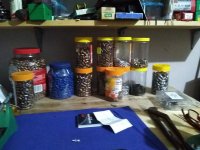LoboGunLeather
US Veteran
I on the other hand, go by alloy characteristics. For Black powder Cartridges I use 30:1 (97% lead: 3% Tin) or 20:1 (95% Lead:5% Tin, 9+/-BHN).
For Modern handgun and sub 1400 fps rifle I use Lyman #2 alloy (90% lead,5% tin, 5% antimony)
For faster velocity I use Wheel Weights (95.5% lead, .5% tin,4% antimony/8.9BHN air cooled 27.1 BHN tempered) or Linotype (86%lead,3%tin,11% antimony/21.8BHN) or Gas Checked bullets of a softer alloy.
For target velocity handguns (around 700 fps) you will want a 7 or so BHN.
For my 45-70 "Must Stop Everything" load I use a 400 grain tempered wheel Weight bullet (27.1BHN) with Gas Check at 2150 fps in a Marlin Guide Gun (will penetrate 1/4"+ steel also block walls!)
The other area of alloy choice is as cast diameter. Different alloys shrink differently as they cool some actually expand!
All this is covered in the Lyman Cast Bullet Handbook #4 (5 is out now) along with loading data for 70 rifle and 23 handgun cartridges!
Ivan
Excellent! Moving right into the post-grad courses here.

